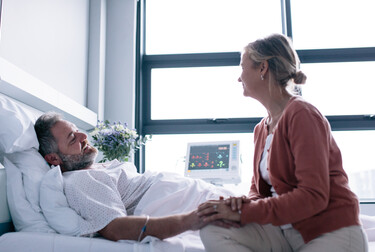Smart Glass for Healthcare Buildings: How Views Improve the Patient Experience

Patient care goes well beyond vital signs and medications. As healthcare organizations strive to attract patients and talent, the quality of their facilities is becoming increasingly important. And for good reason — physical spaces can have meaningful effects on how we feel, how we interact with others, and how we perceive our experiences. Innovative healthcare providers are adopting new technologies and building materials, including smart glass, to improve the patient experience.
Why smart glass? Building owners often select smart glass (also known as electrochromic glass) for its positive effects on occupant comfort. These include glare reduction, temperature regulation, and better views of the outdoors. Cleveland Clinic and Hoag are two good examples of healthcare providers using smart glass systems to increase patient and staff comfort. In fact, smart glass can help improve Hospital Consumer Assessment of Healthcare Providers and Systems (HCAHPS) scores in a number of ways.
Patient Autonomy
While smart glass systems tint automatically in response to outdoor conditions, they can also be controlled using manual switches and smartphone apps. This gives hospital patients the ability to control the tinting of their windows from their beds, eliminating the need for staff to adjust shades and blinds. By reducing the number of steps team members take, smart technologies can free up time for more important tasks. A study done in partnership with Children’s Hospital of Philadelphia shows that patients who are given control of their visual and thermal comfort report increased satisfaction.
Healing and Pain Management
Research suggests that natural light can have tangible healing benefits. For instance, access to natural light and views of the outdoors are correlated with a reduction in the use of opioid analgesic and other analgesic medications. Studies also show that patients with access to natural light use a hospital bed fewer days.
Cleanliness
Blinds and curtains can harbor unwanted hospital guests. And unfortunately, many of these microscopic guests can persist in the environment for extended periods of time. Smart glass systems allow healthcare providers to mitigate infection risks associated with pathogens, dust, and dust mites. And unlike mechanized shades, smart glass systems don’t require ongoing maintenance and repairs.
One Healthcare Provider’s Decision to Embrace Smart Glass
“As a company in the business of health, wellness, care, and rehabilitation, we believe that our buildings should be part of the healing process,” says Jon White, Vice President of Design and Construction at Principle Long Term Care. “The buildings should contribute to the wellness of all building occupants, including patients, residents, staff, and visitors.”
Principle LTC has chosen to work with SageGlass to create smart glass solutions in a number of future building projects. White says that he expects smart glass to help in several ways beyond the obvious improvements in glare, thermal comfort, and energy efficiency. Perhaps most interesting: ample exposure to natural light can have many physiological benefits, including circadian rhythm regulation.
“Research indicates that providing better daylighting could improve alertness, mood, and even sleep,” says White. “And that’s just one of the reasons we’re excited about smart glass.” At SageGlass, we love working closely with providers like Principle LTC to create the best healthcare spaces. And in this case, we have partnered with Saint Gobain, our parent company, to provide smart glass, walls, and ceilings to help meet Principle LTC’s building objectives.